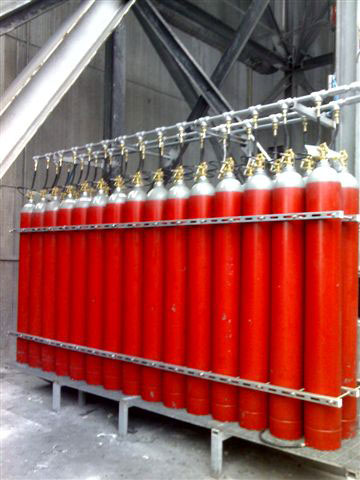Project Description
/details
Carbon dioxide (CO2) has been used since the 1920s in fire extinguishing systems due to its effectiveness and affordability and it is one of the most common and well-known systems of its kind worldwide.
CO2 is a colourless, odourless, non-corrosive, electrically non-conductive gas that does not cause alterations and is kept in special tanks in liquid state. The extinguishing principle is based on oxygen reduction and on cooling due to expansion of the gas.
Our know-how gained in over forty years of experience has allowed us to install thousands of CO2 gas fire extinguishing systems ranging in size from 2 kg to 30,000 kg of carbon dioxide.
NFPA 12 is the reference standard for building a CO2 system; this standard divides these systems into two types: total saturation and local application.
A CO2 gas fire extinguishing system is usually composed of an extinguishing agent storage cylinder, distribution manifold, pipe network to transport the gas, brackets/clips and suitable dispensers calibrated following approved hydraulic calculation; this allows propagation of the gas in the environment with the necessary design concentration.
CO2 is normally stored in one or more storage cylinders (canisters) with capacity ranging from 2 to 140 litres under high pressure; in particular cases involving large volumes, the carbon dioxide is stored in horizontal/vertical large capacity refrigerated tanks under low pressure that can hold up to 30,000 kg of extinguishing agent.
In Italy, Castagna Antincendi is one of the few companies to have designed and installed low pressure CO2 systems and performed refills of extinguishing agent on-site, with the first large system built as early as 1998 in Italy of 30,000 kg of CO2.
Automatic activation of a CO2 gas system occurs through various types of fire detection systems, by means of a manual discharge activation button or by manually operating the lever of the pilot cylinder.
All CASTAGNA ANTINCENDI carbon dioxide (CO2) systems are available in versions KIT, pre-engineered or installed on a turnkey basis.
/applications
Industrial machinery, data centres, transformer rooms, electric panels, museums, chemical and pharmaceutical companies, equipped containers, turbines, filter units, test benches and localised protections in general.
/advantages
Eco-friendly “Clean gas”
Kicks in the first few seconds, limiting damage to a minimum
No residue after discharge so no need for cleanup
Independent fire extinguishing system
Refillable on-site
Less expensive than other extinguishing agents
Suitable for extreme temperatures
Technology sustainable over the long term
Refilling is simple and inexpensive
Easy to restore after use
Available in KITS
After-sales assistance
Refilling is simple and inexpensive
Available according to CE, UNI EN, VdS, NFPA and FM standards
/advantages
Eco-friendly “Clean gas”
Kicks in the first few seconds, limiting damage to a minimum
No residue after discharge so no need for cleanup
Independent fire extinguishing system
Refillable on-site
Less expensive than other extinguishing agents
Suitable for extreme temperatures
Technology sustainable over the long term
Refilling is simple and inexpensive
Easy to restore after use
Available in KITS
After-sales assistance
Refilling is simple and inexpensive
Available according to CE, UNI EN, VdS, NFPA and FM standards
/details
Carbon dioxide (CO2) has been used since the 1920s in fire extinguishing systems due to its effectiveness and affordability and it is one of the most common and well-known systems of its kind worldwide.
CO2 is a colourless, odourless, non-corrosive, electrically non-conductive gas that does not cause alterations and is kept in special tanks in liquid state. The extinguishing principle is based on oxygen reduction and on cooling due to expansion of the gas.
Our know-how gained in over forty years of experience has allowed us to install thousands of CO2 gas fire extinguishing systems ranging in size from 2 kg to 30,000 kg of carbon dioxide.
NFPA 12 is the reference standard for building a CO2 system; this standard divides these systems into two types: total saturation and local application.
A CO2 gas fire extinguishing system is usually composed of an extinguishing agent storage cylinder, distribution manifold, pipe network to transport the gas, brackets/clips and suitable dispensers calibrated following approved hydraulic calculation; this allows propagation of the gas in the environment with the necessary design concentration.
CO2 is normally stored in one or more storage cylinders (canisters) with capacity ranging from 2 to 140 litres under high pressure; in particular cases involving large volumes, the carbon dioxide is stored in horizontal/vertical large capacity refrigerated tanks under low pressure that can hold up to 30,000 kg of extinguishing agent.
In Italy, Castagna Antincendi is one of the few companies to have designed and installed low pressure CO2 systems and performed refills of extinguishing agent on-site, with the first large system built as early as 1998 in Italy of 30,000 kg of CO2.
Automatic activation of a CO2 gas system occurs through various types of fire detection systems, by means of a manual discharge activation button or by manually operating the lever of the pilot cylinder.
All CASTAGNA ANTINCENDI carbon dioxide (CO2) systems are available in versions KIT, pre-engineered or installed on a turnkey basis.
/applications
Industrial machinery, data centres, transformer rooms, electric panels, museums, chemical and pharmaceutical companies, equipped containers, turbines, filter units, test benches and localised protections in general.












